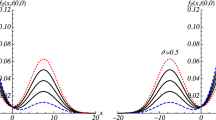Abstract
Motivated by some unsolved problems of biological interest, such as the description of firing probability densities for Leaky Integrate-and-Fire neuronal models, we consider the first-passage-time problem for Gauss-diffusion processes along the line of Mehr and McFadden (J R Stat Soc B 27:505–522, 1965). This is essentially based on a space-time transformation, originally due to Doob (Ann Math Stat 20:393–403, 1949), by which any Gauss-Markov process can expressed in terms of the standard Wiener process. Starting with an analysis that pinpoints certain properties of mean and autocovariance of a Gauss-Markov process, we are led to the formulation of some numerical and time-asymptotically analytical methods for evaluating first-passage-time probability density functions for Gauss-diffusion processes. Implementations for neuronal models under various parameter choices of biological significance confirm the expected excellent accuracy of our methods.
Similar content being viewed by others
References
Abrahams J (1984) Rump crossings for Slepian’s process. IEEE Trans Inf Theory 30(3):574–575
Anderssen R, De Hoog F, Weiss R (1973) On the numerical solution of Brownian motion processes. J Appl Probab 10:409–418
Buonocore A, Caputo L, Pirozzi E (2008) On the evaluation of firing densities for periodically driven neuron models. Math Biosci 214:122–133
Buonocore A, Nobile A, Ricciardi L (1987) A new integral equation for the evaluation of first-passage-time probability densities. Adv Appl Probab 19:784–800
Daniels H (1969) The minimum of a stationary Markov process superimposed on a U-shaped trend. J Appl Probab 6:399–408
Darling D, Siegert A (1953) The first passage time problem for a continuous Markov process. Ann Math Stat 24:624–639
Di Crescenzo A, Nobile A (1995) Diffusion approssimation to queueing systems with time–dependent arrival and service rates. Queueing Syst 19:41–62
Di Crescenzo A, Giorno V, Nobile A, Ricciardi L (1997) On first-passage-time and transition densities for strongly symmetric diffusion processes. Nagoya Math J 145:143–161
Di Nardo E, Nobile A, Pirozzi ELR (2001) A computational approach to first-passage-time problems for Gauss-Markov processes. Adv Appl Probab 33:453–482
Doob J (1949) Heuristic approach to the Kolmogorov–Smirnov theorems. Ann Math Stat 20:393–403
Durbin J (1971) Boundary-crossing probabilities for the Brownian motion and Poisson processes and techniques for computing the power of the Kolmogorov-Smirnov test. J Appl Probab 8:431–453
Durbin J (1985) The first-passage density of a continuous Gauss process to a general boundary. J Appl Probab 22:99–122
Favella L, Reineri M, Ricciardi L, Sacerdote L (1982) First-passage-time problems and some related computational methods. Cybernet Syst 13:95–128
Fortet R (1943) Les fonctions aléatoires du type de Markoff associées à certaines équations lineáires aux dérivées partialles du type parabolique. J Math Pures Appl 22:177–243
Gerstein G, Mandelbrot B (1964) Random walk models for the spike activity of a single neuron. Biophys J 4:41–68
Giorno V, Nobile A, Ricciardi L (1986a) On some diffusion approximations to queueing systems. Adv Appl Probab 18(4):991–1014
Giorno V, Nobile A, Ricciardi L, Sacerdote L (1986b) Some remarks on the Rayleigh process. J Appl Probab 23(2):398–408
Giorno V, Nobile A, Ricciardi L (1987) On some time-non-homogeneous diffusion approximations to queueing systems. Adv Appl Probab 19(4):974–994
Giorno V, Nobile A, Ricciardi L (1988) A new approach to the construction of first–passage–time densities. In: Trappl R (ed) Cybernetics and Systems. Kluwer, Dordrecht, pp 375–381
Giorno V, Nobile A, Ricciardi L (1990) On the asymptotic behaviour of first-passage-time densities for one-dimensional diffusion processes and varying boundaries. Adv Appl Probab 22(4):883–914
Giorno V, Nobile A, Pirozzi E, Ricciardi L (2006) On the construction of first-passage-time densities for diffusion processes. SCMJ 64(2):277–298
Giorno V, Nobile A, Ricciardi L, Sato S (1989) On the evaluation of first-passage-time probability densities via non-singular integral equations. Adv Appl Probab 21(1):20–36
Gutiérrez Jáimez R, Román P, Torres Ruiz F (1995) A note on the Volterra integral equation for the first-passage time probability density. J Appl Probab 32:635–648
Lánský P (1997) Sources of periodical force in noisy integrate-and-fire models of neuronal dynamics. Phys Rev E 55(2):2040–2043
Mehr C, McFadden J (1965) Certain properties of Gaussian processes and their first passage time. J R Stat Soc B 27:505–522
Nobile A, Pirozzi E, Ricciardi L (2006) On the two-boundary first-passage-time problem for Gauss-Markov processes. SCMJ 64(2):421–442
Nobile A, Pirozzi E, Ricciardi L (2007) On the estimation of first-passage time densities for a class of Gauss-Markov processes. LNCS 4739:146–153
Redner S (2001) A guide to first-passage processes. Cambridge University Press, Cambridge
Ricciardi L (1976) On the transformation of diffusion processes into the Wiener process. J Math Anal Appl 54:185–199
Ricciardi L, Lánský P (2002) Diffusion models of neuron activity. In: Arbib M (ed) The handbook of brain theory and neural networks. MIT, Cambridge, pp 343–348
Ricciardi L, Di Crescenzo A, Giorno V, Nobile A (1999) An outline of theoretical and algorithmic approaches to first passage time problems with applications to biological modeling. Math Jpn 50:247–322
Schindler M, Talkner P, Hänggi P (2004) Firing times statistics for driven neuron models: analytic expressions versus numerics. Phys Rev Lett 93(4):048102-1–048102-4
Schindler M, Talkner P, Hänggi P (2005) Escape rates in periodically driven Markov processes. Phys A 351:40–50
Siegert A (1951) On the first passage time probability problem. Phys Rev 81:617–623
Stein R (1965) A theoretical analiysis of neuronal variability. Biophys J 5:173–194
Stein R (1967) Some models of neuronal variability. Biophys J 7:37–68
Tuckwell H (1989) Stochastic processes in the neurosciences. Society for Industrial and Applied Mathematics, Philadelphia
Author information
Authors and Affiliations
Corresponding author
Additional information
This work has been supported in part by Gruppo Nazionale di Calcolo Scientifico of Istituto Nazionale di Alta Matematica and by the Campania Region.
Rights and permissions
About this article
Cite this article
Buonocore, A., Caputo, L., Pirozzi, E. et al. The First Passage Time Problem for Gauss-Diffusion Processes: Algorithmic Approaches and Applications to LIF Neuronal Model. Methodol Comput Appl Probab 13, 29–57 (2011). https://doi.org/10.1007/s11009-009-9132-8
Received:
Revised:
Accepted:
Published:
Issue Date:
DOI: https://doi.org/10.1007/s11009-009-9132-8




